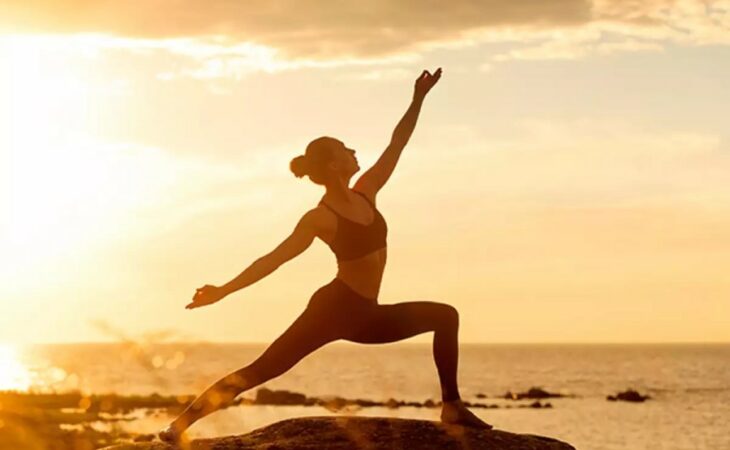When you hear “yoga”, the first thing that comes to your mind is certainly these people turned in on themselves, who put themselves in postures all more delirious than the others. They are yogis: they have been practicing yoga for years. You can either see them as inspiration or forget about them and focus on yourself instead.
Yoga is a philosophical teaching from India whose principle is above all to link body, mind and soul . Postures performed on a yoga mat – called asanas – are not only designed to achieve this goal, but are also the ideal workout to strengthen the core, in addition to improving coordination of movement and flexibility . Yoga, during a session, also brings a lot of benefits at the mental level.
In a yoga class for beginners, you start out smoothly and the exercises offered are easier. In this way, you test your flexibility and you learn to feel your own body, as well as to relate your movements to your breathing. Feeling your own body, as you learn in yoga, can also benefit you in other sports.
Table of Contents
What is the best type of yoga to start practicing?
If you are a beginner and looking for the most suitable style of yoga for your level, it would also be useful to ask yourself another question, namely: what do you want to achieve? Each style of yoga has its own benefits. Do you want something rather calm? In this case, we recommend yin yoga. Yoga schools can sometimes offer a session dedicated to calm.
On the contrary, vinyasa flow , or even power yoga , will make you sweat profusely during a session. The way a class is organized depends on the type of yoga taught and the teacher.
In most classes, you practice with a group guided by a teacher who sets the pace. The asanas and the order in which they are performed can vary from week to week. In schools where hot yoga or ashtanga are taught, it is still different. Often, the teacher teaches the same sequence every week.
However, all styles of yoga have as a common point postures from the same repertoire. Only the type of class, the pace and the order in which the postures are performed differ between each style of yoga.
There is no one style of yoga more suited to the practice of beginners. The best is to ask yourself what you really want and then give it a try. Yoga should be fun. But it also doesn’t hurt to try something that initially doesn’t seem right for you.
You might discover a whole different side of your personality. What’s more, stepping out of your comfort zone has never hurt anyone.
How to start yoga when you have never done it?
1. Find out your why
Especially if you live in a big city with a lot of options, from yin yoga to power yoga to kundalini yoga , you will see that the choice is not lacking! Ask yourself why you want to practice yoga and what are the important criteria for you concerning the class itself or the school. Find yoga schools that match your criteria and choose a style that suits your goal.
2. Find a yoga school
For your first steps in the practice of yoga, it would be better to find yourself a school. Practicing in a group is much more fun and under the guidance of a qualified teacher , you practice together in a sequence made for you, adapted to the level of the group. If something is wrong, the teacher will help you and suggest other variations.
3. Find your routine
For some, yoga immediately brings pleasure. For others, this is not the case. It makes sense: the better you can do something, the more fun is present when you do it. So don’t give up right away if the first session didn’t go perfectly. Take the time to familiarize yourself with the exercises and take the classes regularly. Practicing in a class 2-3 times a week for a month will give you an idea of which style, teacher, and school are right for you. If you don’t like one school, just try another.
4. Be realistic
Head posture, lotus position, or any other fancy posture does not belong to a beginner yoga class. It’s like you wake up one morning and go run the marathon just because it’s always been your dream to run. There are too many risks for it to go wrong and hurt yourself. Ask the yoga school which class would suit your level, and follow the recommendation first.
5. Don’t compare yourself to others
Sounds easier than it actually is. But between us be said: why, as a beginner, should you compare yourself to someone else who has been exercising for years? Or, on the contrary, feel like you are above other beginners, because, although a novice in yoga, you have years of ballet dance under your belt and do not find it difficult to make the splits? Stay focused on yourself and what you already know how to do. Your breathing helps you anchor yourself in the present moment. Here, as is generally the case in sport, you should know that each body is different. And this is very well so.
6. Don’t get too excited
Take your first tests quietly. Forcing yourself and wanting too much is counterproductive in this context. Do a little check: are you feeling good? Are all the joints still in their place? Don’t you hurt anywhere? Does this position bring you anything? If all is well, you can go beyond your comfort zone and experience the asana a little deeper. But don’t forget to stay in touch with your breath.
Do not eat too much before the session either. Between this and your last meal, it should be about 3 hours . Before class, drink something warm, it’s good for the stomach and good for the soul. Hot water is not too bad. But an infusion tastes much better. Try, for example, our All day vitality or our Balance & Protection .
7. Don’t put pressure on yourself
You are neither too weak for strength training nor too slow to run. Chances are, at first – and maybe even for a while – you won’t be able to fully extend your legs in the downward dog pose. It does not matter. Yoga is the perfect discipline to work on flexibility .
As with strength training or endurance, each exercise has an easier variation than you too can manage to do . If you can’t do something, ask your yoga teacher for advice.
Once the excitement of the first session has worn off and you now know the basic exercises, you will notice that yoga provides a feeling of well-being in addition to improving strength and flexibility. During a yoga session, there is no rush, you focus on your breathing and your body and you create a space where your thoughts slow down and where you can focus on the essentials.
8. Learn yoga online rather than at school
You don’t want to go to a school to spend between 60 and 90 minutes on a yoga mat, do you want to start now? It’s okay, find yourself an easy video lesson that you can do at home; it can last, 5, 10, even 50 minutes.
But here too it is important to choose a course suitable for beginners . No complicated postures or jumps, but slow and precise movements.
In fact, even bending forward or backward can put excessive strain on the spine and intervertebral discs if the exercise is not performed correctly. If you are starting yoga practice at home, you should be doubly careful and really only do what does not seem dangerous to you at all.
Online yoga session
You can find various yoga teachers who have created their own videos and offer online classes for beginners that are starting from scratch. You can learn the sun salutation, various other yoga postures, how to gain flexibility, how to mobilize the entire spine, etc.
Good to know for beginners
If you are a beginner, we would like to recommend that you take a closer look at the postures performed in almost all yoga classes and which are linked, in part, one after the other. Even when it comes to seemingly easy movements, it’s worth looking twice rather than once.
Yoga for beginners: our conclusion
- Yoga is a teaching from India.
- The principle of teaching yoga is to link body, mind and soul.
- Yoga postures are called “asanas”.
- If you are just starting out, you need to know how to listen to your own needs.
- Start without putting pressure on yourself and try to familiarize yourself with the basics of yoga before attempting more advanced postures.











